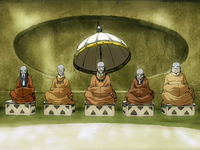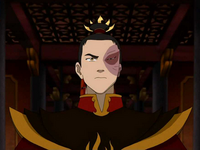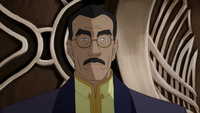Politics and government in the World of Avatar vary significantly between the different nations. There are five basic types of political systems, each of which has a distinctive character that corresponds with the element or ideology of its respective nation. The Air Nomads had a theocracy led by four councils of monks or nuns;[1] the Water Tribe has a tribal system which was led by two separate chiefdoms in the North and South Poles until the conclusion of the Hundred Year War;[2][3] the Earth Kingdom has a confederate monarchy led by an earth monarch;[4] the Fire Nation has an absolute monarchy led by the Fire Lord;[5] and the United Republic of Nations has a democracy led by an elected president.[3]
The Avatar acts independently of all states as a means of maintaining peace and order among the four nations, and also serves as a mediator between Earth and the Spirit World.[5]
Air Nomads
- Main article: Air Nomads

Each air temple was run by a separate Council of Elders.
Government system: Theocracy
Head of state: No overall head of state
Current head of state: None
Territorial divisions: Four temples
Capital: No overall capital
The Air Nomads had no overall government that made unified decisions. Instead, there were four Councils of Elders that presided over each of the four temples. These assemblies consisted of wise and experienced airbending masters, either entirely monks or nuns, that made decisions regarding the temple and its people. However, in comparison to the political systems of the other nations, the Council of Elders had little real authority, and only served as supervisors or managers. The Southern Air Temple had five monks on its Council of Elders, including High Monk Pasang, Tashi, and Gyatso.[1] Sister Iio was the Mother Superior and thus the head of the council in the Eastern Air Temple.
To preserve the Air Nomad culture, Aang founded the Air Acolytes, and over time, they grew to be the cultural successors of the Air Nomads, namely the Air Nation. Like the other nations, they too had a political representative on the United Republic Council. As the sole living airbending master and the son of Avatar Aang, Tenzin had a great amount of influence among the Air Acolytes and was held in high regard. Each air temple is administered by an abbot.[6]
Water Tribe
- Main article: Water Tribe

Hakoda was one of the local chiefs of the Southern Water Tribe during the Hundred Year War.
Government system: Tribal chiefdom/Royal chiefdom
Head of state: Tribal chief
Territorial divisions: Two tribes, plus Foggy Swamp
Capital: No overall capital
The Water Tribe originally did not have an overall leader. After the Hundred Year War, both its main divisions fell under the rule of one chief.[7] Following a civil war, the Southern Water Tribe became independent and is now ruled by its own chief.[8]
Foggy Swamp Tribe
- Main article: Foggy Swamp Tribe
Little is known about the politics of the Foggy Swamp Tribe. However, Huu seemed to have some kind of authority, although his relationship with the rest of the tribe is fairly informal.[9]
Northern Water Tribe
- Main article: Northern Water Tribe
Title of leader: Chief
Most recent known leader: Desna and Eska
Capital: Northern Water Tribe City
Politics in the Northern Water Tribe are more complicated than in its southern sister tribe. There is one all-powerful leader, but there is a small council that advises him, most recently including the tribe's greatest waterbending master, Pakku. Politics can also be personal. For example, marrying the chief's daughter, the Tribal Princess, can be a significant step in a political career.[2][10]
Southern Water Tribe
- Main article: Southern Water Tribe
Title of leader: Chief
Most recent known leader: Tonraq[8]
Capital: Harbor city
Decisions in the Southern Water Tribe are made exclusively by the current chief, and politics appear to be extremely simple, with only one person in power and all others completely loyal to that person. Unlike in the Northern Water Tribe, the chief's children, such as Katara and Sokka, are not viewed as royalty.[11] Korra, by virtue of her uncle being Northern chieftain, is technically royalty, but still treated as lower class.
In recent years, its structure became more readily defined, with its Council of Chieftains handling day-to-day affairs of state and possessing its own judicial system. Due to the South's independence from the North, the council now elects their own chieftain into office.[8]
Earth Kingdom
- Main article: Earth Kingdom

Earth Queen Hou-Ting ruled the Earth Kingdom until 171 AG.
Government system: Confederate Constitutional Monarchy
Head of state: Earth monarch
Most recent known head of state: Hou-Ting
Territorial divisions: Various semi-independent provinces
Territorial divisions led by: Kings, governors, mayors
Capital: Ba Sing Se
Though the ruler of Ba Sing Se, titled as the Earth King or Queen, is the official overall leader of the Earth Kingdom, the country functions as a sort of confederation, with individual provinces and cities given a great deal of autonomy. Outside of the cities, the central government has little influence. Furthermore, the Earth Kingdom has no unified system of laws, with each region having its own legal code.[12] These territories do, however, provide support and troops to the Earth King whenever necessary, and the military functions as a unified body.[4]
Ba Sing Se
- Main article: Ba Sing Se
Title of leader: Earth King or Queen
Most recent known leader: Hou-Ting
The earth monarch is the leader of the government of Ba Sing Se, and by extension the entire Earth Kingdom. It should be noted that the day-to-day affairs of the city are managed by the Grand Secretariat, who answers only to the monarch.
Omashu
- Main article: Omashu
Title of leader: King
Most recent known leader: Bumi
Omashu, though part of the Earth Kingdom and therefore answerable to the Earth King in Ba Sing Se, has its own king and is relatively autonomous of the capital.[13]
Zaofu
- Main article: Zaofu
Title of leader: Matriarch
Most recent known leader: Suyin Beifong
Zaofu was founded and built by Suyin, head of the Metal Clan and daughter of the famous Toph Beifong. Like Omashu, it is part of the Earth Kingdom while staying autonomous of the capital.[14]
Fire Nation
- Main article: Fire Nation

Zuko was crowned Fire Lord after the end of the Hundred Year War.
Government system: Autocratic Absolute Monarchy
Head of state: Fire Lord
Most recent known head of state: Fire Lord Zuko's daughter
Territorial divisions: Homeland and colonies
Territorial divisions led by: Governors
Capital: Fire Nation Capital
The Fire Lord's firstborn child is the Heir to the Fire Lord, usually referred to as the Crown Prince or the Crown Princess.[5]
Sun Warriors
- Main article: Sun Warriors
Government system: Tribal Chiefdom
Head of state: Chief
Most recent known head of state: Sun Warrior chief
Capital: Sun Warriors' ancient city
Although the Sun Warriors are firebenders, they are independent of the rest of the Fire Nation and are led by their own Chief.[15]
United Republic of Nations
- Main article: United Republic of Nations

The United Republic of Nations became a presidential republic in the aftermath of the Anti-bending Revolution, with Raiko as its first president.
Government system: Unitary Presidential Republic
Head of state: President
Capital: Republic City
The United Republic of Nations was formerly led by the United Republic Council, which was composed of one representative from each major nation, who represented the interest of their people.[16] However, in the aftermath of the Anti-bending Revolution, it was decided that this political system was flawed because it did not sufficiently represent the interests of the majority. The United Republic Council was dissolved and an elected president was designated as the new head of state,[3] thus making it the first and so far only democracy in the World of Avatar.